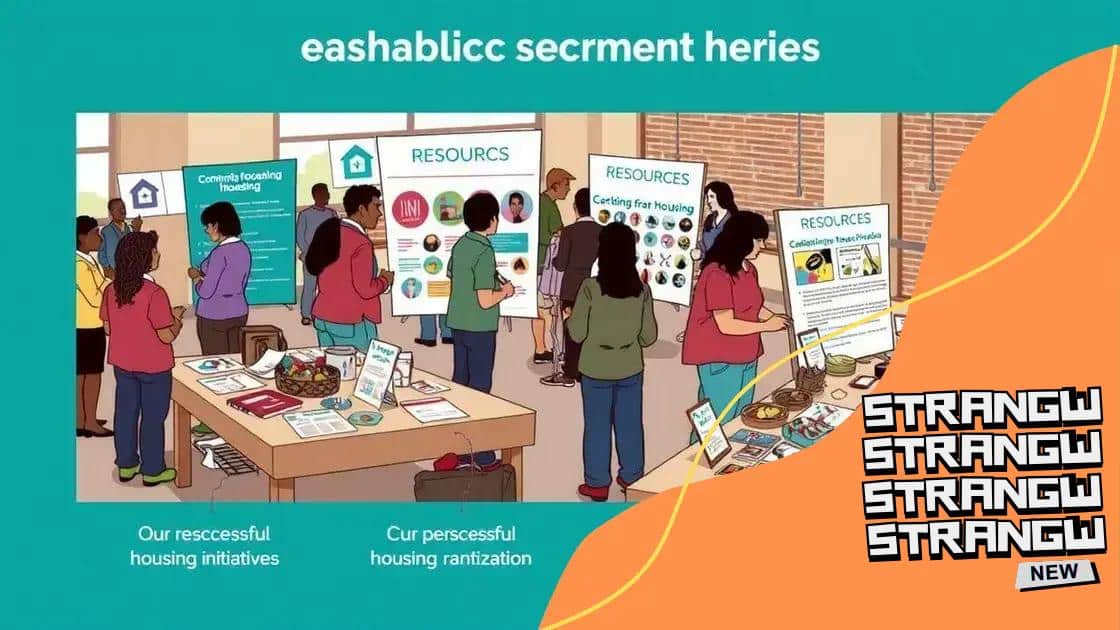How federal government is addressing housing insecurity

The federal government addresses housing insecurity through policies and programs that aim to provide affordable housing, support services, and resources to vulnerable populations, helping prevent homelessness and improve community well-being.
How federal government is addressing housing insecurity is a pressing issue today. Many families face unstable living conditions, prompting increased attention to government strategies and initiatives. Let’s explore how these actions can shape better outcomes.
Understanding housing insecurity
Understanding housing insecurity is crucial in today’s world. Many individuals and families experience difficulties in finding affordable and stable housing. This can lead to various challenges, including stress and health issues.
Housing insecurity occurs when individuals lack access to safe and reliable housing. It can affect people at different life stages, from young families to seniors. Several factors contribute to this issue, including low income, rising housing costs, and limited availability of affordable options.
Factors Contributing to Housing Insecurity
Many elements drive housing insecurity in communities. Addressing these contributing factors is essential to finding effective solutions. Here are some key factors:
- Low wages: Many jobs do not pay enough to cover basic living expenses, including rent.
- High housing costs: In some areas, housing prices have surged beyond the reach of average earners.
- Unstable employment: Job insecurity can prevent individuals from maintaining consistent housing.
- Limited affordable units: A shortage of affordable housing can leave many homeless or at risk of eviction.
The consequences of housing insecurity can be severe. Not having a stable home can affect physical and mental health, children’s education, and overall well-being. Communities with high rates of homelessness or housing instability often face additional social challenges, such as crime and poverty.
Local governments and non-profits play a significant role in addressing these challenges. They work to improve access to affordable housing and provide essential services. By collaborating with community members and stakeholders, effective strategies can be developed to alleviate housing insecurity.
Federal policies on housing
Federal policies on housing play a vital role in addressing the crisis of housing insecurity. These policies aim to create affordable housing solutions and to provide support for those in need. Understanding how these initiatives work can help us recognize the positive changes in communities.
Several key programs are in place that focus on different aspects of housing assistance. For instance, HUD, or the Department of Housing and Urban Development, is responsible for many housing programs that support low-income families. Their programs include rental assistance and community planning initiatives.
Main Federal Housing Policies
Among the various federal housing policies, a few stand out due to their significant impact:
- Section 8 Housing Choice Voucher Program: This program allows low-income families to choose affordable housing in the market.
- Low-Income Housing Tax Credit (LIHTC): This encourages the development of affordable rental housing.
- HOME Investment Partnerships Program: This program provides federal funds to states and localities to create affordable housing.
- Continuum of Care Program: This program helps communities provide assistance to individuals experiencing homelessness.
The effectiveness of these policies can be seen in their ability to help families secure stable housing. For example, the Section 8 program has enabled many families to find homes that fit their needs. Coupled with local government initiatives, these federal programs address both the immediate and long-term needs of communities.
Despite their benefits, federal housing policies face challenges. Funding can vary each year, impacting consistent support for housing programs. Additionally, some areas may lack access to certain initiatives, leaving gaps in assistance. Collaboration between federal and state authorities is essential for ensuring comprehensive coverage.
Successful programs and initiatives

Successful programs and initiatives play a crucial role in combating housing insecurity. These programs are designed to provide support and resources to individuals and families facing housing challenges. By understanding these initiatives, we can see how they make a positive difference in communities.
Several successful programs exist across the country that focus on various aspects of housing assistance. The support offered through these programs is essential for helping families achieve stable living situations.
Notable Successful Programs
Among the many initiatives available, a few have stood out due to their effectiveness:
- Rapid Re-Housing: This program provides short-term financial assistance and services to help individuals and families quickly exit homelessness.
- Supportive Housing: This initiative combines affordable housing with supportive services, addressing both economic and personal needs.
- Housing First: This approach prioritizes providing permanent housing to homeless individuals, without preconditions.
- Community Development Block Grants (CDBG): These funds are allocated to support community development, including affordable housing projects.
These initiatives demonstrate the potential for real change when effective strategies are implemented. For example, Rapid Re-Housing has successfully helped thousands transition from homelessness to stable housing. The combination of financial support and services creates a pathway for many families to regain independence.
Furthermore, community involvement enhances the success of these programs. Local organizations often partner with government agencies to provide additional resources. This collaboration is essential in tailoring solutions to fit the unique needs of communities.
While many programs are making strides, challenges remain. Ongoing funding and resource allocation are critical to ensure these initiatives continue to operate effectively. Advocacy for policy changes and support at various governmental levels is vital for sustainable progress.
Challenges in addressing homelessness
Challenges in addressing homelessness stem from various factors that complicate the issue. Understanding these challenges is essential for creating effective solutions. Many individuals and families face homelessness due to circumstances beyond their control, such as job loss or health crises.
One major challenge is the lack of affordable housing. Many cities see rising rents that outpace wages, making it difficult for low-income families to find stable living arrangements. This issue often leads to increased homelessness, pushing families to the streets or temporary shelters.
Key Challenges in Addressing Homelessness
Several key obstacles complicate efforts to provide adequate support for homeless populations:
- Insufficient funding: Many programs rely on government and private funding, which can be inconsistent and inadequate.
- Limited resources: Shelters and support services often lack the resources to help everyone who needs assistance.
- Stigma and misconceptions: Society may hold negative views about homelessness, impacting support and understanding.
- Mental health and addiction issues: Many individuals who are homeless face mental health challenges or substance abuse, making it harder to find stable housing.
These challenges affect not just those experiencing homelessness but also the communities around them. Rising homelessness can strain local services and resources, affecting overall community health and safety. Additionally, solutions must address the complexity of each individual’s situation.
Efforts to combat homelessness must acknowledge these barriers and work towards comprehensive strategies. Collaboration among government, non-profit organizations, and community members is vital. Creating affordable housing, providing mental health services, and increasing public awareness can lead to more effective interventions.
While progress is being made in some areas, ongoing advocacy and innovative solutions are necessary to address these persistent challenges effectively.
The role of community organizations
The role of community organizations in addressing housing insecurity is critical. These organizations work at the grassroots level to provide support and resources for individuals and families. By understanding their contributions, we can appreciate how they help improve local communities.
Community organizations often offer vital services such as housing assistance, advocacy, and education on housing rights. Their efforts play a significant part in connecting vulnerable populations with needed resources, helping them to avoid or escape homelessness.
Key Functions of Community Organizations
Many community organizations focus on specific areas related to housing insecurity, and their functions can include:
- Direct assistance: Many provide financial help for rent and utilities, enabling families to keep their homes.
- Support services: These may include counseling for mental health, job training, and legal aid for housing rights.
- Advocacy: Organizations often advocate for policies that promote affordable housing and fight against unfair evictions.
- Community development: Some work on broader initiatives to improve neighborhoods through affordable housing projects.
By offering these services, community organizations directly impact the lives of individuals facing housing insecurity. They create a support network that empowers people to seek help. For example, many families gain access to essential resources through these organizations, helping them secure stable housing.
Collaboration is another significant aspect of their role. Community organizations frequently partner with government agencies, non-profits, and local businesses. These partnerships enhance their capacity to address housing issues comprehensively. By leveraging resources and sharing expertise, these collaborations often lead to innovative solutions.
Community involvement is essential for the success of these organizations. Engaging local volunteers and residents creates a sense of ownership and strengthens community ties. As more people participate, the impact of these organizations grows, amplifying their effectiveness.
FAQ – Frequently Asked Questions about Housing Insecurity
What is housing insecurity?
Housing insecurity refers to a lack of stable and affordable housing, leading to risks of eviction, homelessness, or living in unsafe conditions.
How does federal government address housing insecurity?
The federal government addresses housing insecurity through policies and programs that aim to provide affordable housing options and financial assistance to low-income families.
What role do community organizations play in tackling homelessness?
Community organizations provide essential support services, advocacy, and resources that help individuals and families facing housing insecurity and homelessness.
What are some successful programs that help with housing insecurity?
Successful programs include Rapid Re-Housing, Supportive Housing, and the Housing First approach, which focus on providing immediate assistance and long-term solutions for those in need.





